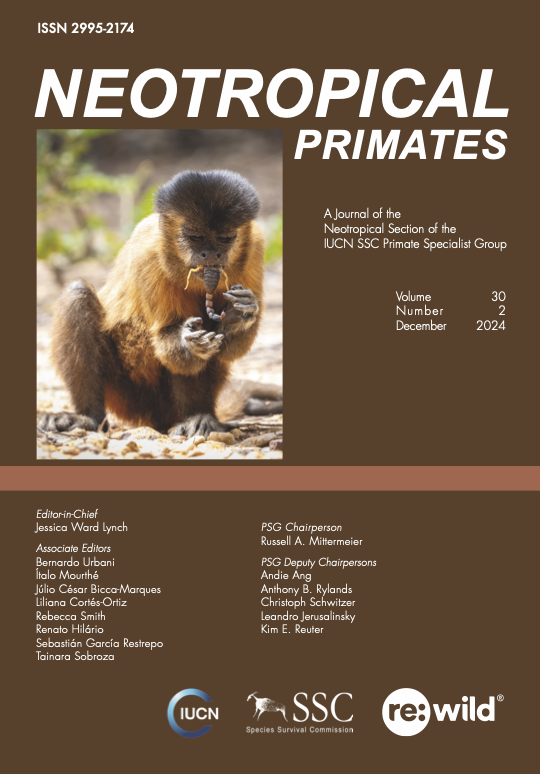Notas sobre la estructura de un grupo de Alouatta seniculus seniculus (Primates: Atelidae), en Limoncocha, Ecuador
DOI:
https://doi.org/10.62015/np.2024.v30.36Abstract
Population structure in primate groups in the Ecuadorian Amazon is little studied. The present observations occurred in Limoncocha, Sucumbíos province, Ecuador. We observed a group of red howlers (Alouatta seniculus), composed of nine individuals: three adult males, two adult females, two pregnant females and two juveniles, one of them male. The group was observed moving among the branches of the trees until they stopped in search of food and settled down to spend the night. In the place used as a sleeping site, adults fed on leaves while the juveniles played until 17h30 when they settled down for the night. By 7h30 the next morning the group had moved on to another location. Information on the group composition for A. seniculus in Amazonian Ecuador is scarce, so this observation contributes to our knowledge of it.
References
Blake, J. G., Guerra, J., Mosquera, D., Torres, R., Loiselle, B. A. y Romo, D. 2010. Use of mineral licks by white-bellied spider monkeys (Ateles belzebuth) and red howler monkeys (Alouatta seniculus) in Eastern Ecuador. Int. J. Primatol. 31: 471–483. https://doi.org/10.1007/s10764-010-9407-5
Braza, F., Alvarez, F. y Azcarate, T. 1981. Behaviour of the red howler monkey (Alouatta seniculus) in the Llanos of Venezuela. Primates 22: 459‒473. https://doi.org/10.1007/BF02381238
Cortés-Ortiz, L., Rylands, A. B. y Mittermeier, R. A. 2015. The taxonomy of howler monkeys: integrating old and new knowledge from morphological and genetic studies. En: Howler Monkeys: Adaptive Radiation, Systematics, and Morphology, M. Kowalewski, P. Garber, L. Cortés-Ortiz, B. Urbani y D. Youlatos (eds.), pp.55–84. Springer, New York, NY. https://doi.org/10.1007/978-1-4939-1957-4_3
Defler, T. R. 2010. Historia Natural de los Primates Colombianos. Universidad Nacional de Colombia. Facultad de Ciencias. Departamento de Biología, Bogotá.
Dias, P. A. D. y Rangel-Negrín, A. 2015. Diets of Howler Monkeys. En: Howler Monkeys. Behavior, Ecology, and Conservation, M. Kowalewski, P. Garber, L. Cortés-Ortiz, B. Urbani y D. Youlatos (eds.), pp.21–56. Springer, New York. https://doi.org/10.1007/978-1-4939-1960-4_2
Doyle, E. D., Prates, I., Sampaio, I., Koiffmann, C., Silva, W. A., Carnaval, A. C. y Harris, E. E. 2020. Molecular phylogenetic inference of the howler monkey radiation (Primates: Alouatta). Primates 62: 177–188. https://doi.org/10.1007/s10329-020-00854-x
Estrada, A. y Garber, P. A. 2009. Comparative perspectives in the study of South American primates: research priorities and conservation imperatives. En: South American Primates: Comparative Perspectives in the Study of Behavior, Ecology, and Conservation, P. A. Garber, A. Estrada, J. C. Bicca-Marques, E. W. Heymann y K. B. Strier (eds.), pp.509‒531. Springer, New York. https://doi.org/10.1007/978-0-387-78705-3
Hill, W. C. O. 1962. Primates Comparative Anatomy and Taxonomy V. Cebidae Part B. Edinburgh University Press, Edinburgh.
Link, A., Palacios, E., Cortés-Ortiz, L., Stevenson, P. R., Cornejo, F. M., Mittermeier, R. A., Shanee, S., de la Torre, S., Boubli, J. P., Guzmán-Caro, D. C., Moscoso, P., Urbani, B. y Seyjagat, J. 2021. Alouatta seniculus. The IUCN Red List of Threatened Species 2021: e.T198676562A198687134. Website: https://dx.doi.org/10.2305/IUCN.UK.2021-2.RLTS.T198676562A198687134.en. Accessed 15 February
MAE (Ministerio del Ambiente del Ecuador). 2013. Sistema de Clasificación de los Ecosistemas del Ecuador Continental. Subsecretaría de Patrimonio Natural, Quito.
Martin-Solano S., Carrillo-Bilbao, G. A., de la Torre, S. y Tirira, D. G. 2018. Mono Aullador Rojo de Linneo Alouatta seniculus (Linnaeus, 1766). En: Estado de conservación de los primates del Ecuador, D. G. Tirira, S. de la Torre y G. Zapata-Ríos (eds), pp.155‒161. Grupo
de Estudio de los Primates de Ecuador y Asociación Ecuatoriana de Mastozoología, Quito.
Morales-Jiménez, A. L. 2002. Densidad de los monos aulladores (Alouatta seniculus) en un bosque subandino, Risaralda, Colombia. Neotrop. Primates 10: 141‒144. https://doi.org/10.62015/np.2002.v10.522
Ochoa, D. F., Martínez, E. y De la Ossa, J. 2011. Densidad poblacional y estructura de grupo de Alouatta seniculus (Primates: Atelidae) en Colosó, Sucre, Colombia. Rev. U.D.C.A. Actual. Divulg. Cient. 14: 101‒108. https://doi.org/10.31910/rudca.v14.n2.2011.780
Pullido, M. T. 1997. Notes on the dispersal behavior of howler monkeys (Alouatta seniculus). Field Studies of Fauna and Flora at La Macarena, Colombia 10: 7‒11.
Ruiz-García, M., Lichilin, N., Escobar-Armel, P., Rodríguez, G. y Gutierrez-Espeleta, G. 2016. Microsatellite DNA analyses of four Alouatta species (Atelidae, Primates): evolutionary microsatellite dynamics. En: Phylogeny, Molecular Population Genetics, Evolutionary Biology and Conservation of the Neotropical Primates, M. Ruiz-Garcia y J. M. Shostell (eds.), pp.369–394. Nova Science Publishers, New York.
Rylands, A. B., Mittermeier, R. A., Cornejo, F. M., Defler, T. R., Glander, K. E., Konstant, W. R., Pinto, L. P. y Talebi, M. 2013. Family Atelidae (Howlers, Spider and Woolly Monkeys and Muriquis). En: Handbook of the Mammals of the World. Vol. 3. Primates, R. A. Mittermeier, A. B. Rylands y D. E. Wilson (eds.), pp.484–549. Lynx, Barcelona.
Smith, N. 2023. Amazon Fruits: An Ethnobotanical Journey. Springer Nature, Switzerland. https://doi.org/10.1007/978-3-031-12803-5
Stanyon, R., Tofanelli, S., Morescalchi, M. A., Agoramoorthy, G., Ryder, O. A., y Wienberg, J. 1995. Cytogenetic analysis shows extensive genomic rearrangements between red howler (Alouatta seniculus Linnaeus) subspecies. Am. J. Primatol. 35: 171–183. https://doi.org/10.1002/ajp.1350350302
Wilson, D. E. y Reeder, D. M. 2005. Mammal species of the world: a taxonomic and geographic reference. Johns Hopkins University Press, Baltimore.
Downloads
Published
Issue
Section
License
Copyright (c) 2025 Salomón M. Ramírez-Jaramillo, Alejandro Mesías, Lizbeth C. Andi-Grefa

This work is licensed under a Creative Commons Attribution-NonCommercial-ShareAlike 4.0 International License.



